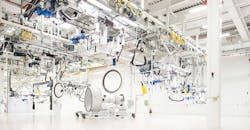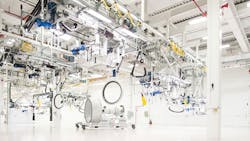Manufacturing Leader Reveals Secret to Staying on Top
A new report from Washington, D.C.-based think tank Lexington Institute concludes there are clear-cut lessons about survival and in fact, growth, from those old-line manufacturers who have evolved and thrived in the brutally competitive global 21st century marketplace. The report, The New Landscape in American Manufacturing, cited my company, Pratt & Whitney, the 90-year old jet engine manufacturing unit of United Technologies, as one example, as well as Boeing, Caterpillar and Ford.
The report found that these companies continue to be successful because they embraced the practice of continuous improvement, enabling them to weather the disruption caused by globalization and digitization that caught fire and impacted so many old-line companies in the 1990s and still does well into the second decade of the 21st century.
The Japanese word "Kaizen" translates to "change for the better," and the philosophy has been adopted by some of the most successful global companies.
These companies developed innovative new products to meet changing customer demands, and adapted to the changing environment by shifting from being organized as vertically integrated organizations to businesses that focus on their core competencies while adopting an extended enterprise model that relies heavily on a network of best-in-class suppliers, no matter their size. Additionally, these successful manufacturers embraced lean manufacturing practices, again depending on suppliers to deliver on-time and at required quality standards, and to use new information technologies to manage and monitor workflow and performance.
At Pratt & Whitney, where we are ramping up our plants in the U.S. to meet customer demands for our new energy-efficient, low emission and extremely quiet commercial jet engine, the geared turbofan, we see three connected requirements for our success:
First, we have to keep investing in new manufacturing technologies to improve our efficiencies. For us, that means expanding our use of additive manufacturing, or 3D-printing of parts, where we have been a pioneer, powder metallurgy, another area where we are a pioneer and which can replace traditional and more time-consuming forging of parts, assembly-line robotics and the use of intelligent cells to speed up our assembly process.
Second, and this confirms the extended enterprise finding from the Lexington report, we closely collaborate with 450 suppliers in the U.S. and around the world to ensure that they deliver the thousands of parts and components our engines require on time and at perfect quality. This is not rhetoric but is how we must operate to compete. Thirty years ago, we made 50 percent of the parts we used; today, we make only 20 percent and depend on our suppliers for 80 percent.
Our collaboration with suppliers is critical. For a jet engine, you can’t accept parts delivered late, or below required quality. So we have 200 engineers who make regular visits to our suppliers to ensure they are on schedule with what they have contracted for. We sign long-term agreements with our best suppliers so that they have the predictable income to meet our rigorous schedule and they, in turn, can invest in the equipment, people and training we require.
Other tasks are being managed by suppliers (some of which are local to assembly facilities) to produce our engine components more efficiently. They are often smaller companies like Whitcraft, Aero Gear, Polamer Precision and J&L Machine, to name just a few. We transfer our technology expertise to them, and they become more competitive within their marketplace and are often able to expand their business to new customers as a result of this process.
Pratt & Whitney's Innovative Horizontal Assembly Line.
Photo: United Technologies
And third, we invest in continuous training of our manufacturing workers and those who work for many of our suppliers. Because the performance of suppliers is so crucial to our success, we take an active role in supporting training programs that sustain the skills needed in the supply chain. We frequently partner with community colleges that provide the training to enable machinists and other assembly line workers to keep current with new processes and technologies. In fact, we have invested more than $9 million in these programs over the past five years. Again, the colleges often include names unfamiliar to the general public such as Goodwin College in East Hartford, Connecticut and York County Community College in Maine, but these and other superb schools we partner with enable our suppliers in those areas and our company to recruit and train the skilled manufacturing workers we must have.
We think the “extended enterprise” is very real and these smaller companies and community colleges have been essential to the success of larger companies like Pratt & Whitney. That will likely continue as we continue to grow and evolve and our smaller suppliers grow into larger companies.
This article originally appeared in IndustryWeek, a Penton brand, as is used with permission.



